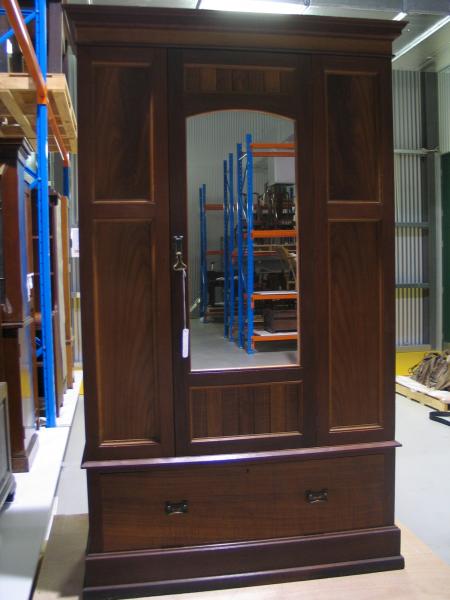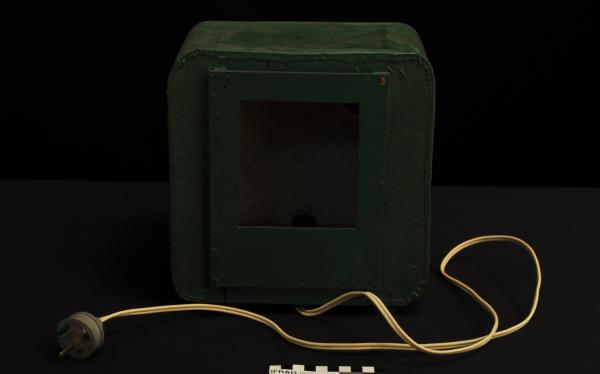Lady's cylinder-action workbox in the shape of a roll top desk. Basic structure is of wood overlaid almost entirely inside and out with an intricate parquetry of natural and lightly coloured brown and green straw strips in geometric patterns. The straw work has been fixed to a paper backing which has been glued to the wood and some of the appertures in the box have been painted pink.
The box has four main sections. The hinged lid at the top lifts to reveal a tray containing three square compartments, each decorated on the inside with straw parquetry, the central tray particularly intrictately patterned. On the inside of the lid is a mirror, flanked by panels of parquetry.
A roll top of curved metal has a parquetry covered wooden edge with a round bone handle and a catch which slips into the hinged lower front cover when this is in the the raised position. Beneath, under the curve of the roll top, is a removable platform on the front of which on each side are two triangular mirrors with a drawer below. Between, is a clear glass window with a small painting set well back behind it. It shows a vase containing a bunch of flowers under fringed, red and green curtains. Visible surfaces in this section are covered with straw parquetry.
Beneath the platform is a 3.8cm high unit, the entire depth of the workbox, which can be pulled out halfway with a round, carved, bone knob. From the top, four square recesses covered by doors/flaps with ribbon pull tabs can be accessed with an octagonal door/flap at the centre. Parquetry in geometric designs cover all internal and external surfaces. This section overhangs the lower section by 2 cm and gives the impression of the work table of a roll top desk.
The lower section is covered in front by a hinged door which opens downward when the workbox is in use. There are two 11.3cm wide drawers in the centre of the lower section which run the depth of the workbox. These are flanked by a 6cm deep x 3cm wide drawer on the left and right; the edges of the drawers are painted pink and straw parquetry covers all surfaces. Each of the drawers has a round, carved bone handle and there is small shell in the top drawer. As with all the outside surfaces of the workbox, straw parquetry in various geometric patterns covers the outside of the hinged door which has diamond shaped painting of 6 flags with trees in the background at its centre. (Originally this was what would have been covered by glass). On the curved sections of the exterior of the box, in diamond shaped recesses, are two paintings. The one on the right is of a woman holding a basket of flowers in one hand and a rose in the other; in the left is a man with a stick or whip in one hand and a flower in the other. Both figures stand on a brown, square-tiled floor under green and red fringed curtains.
(NB: Shirley S. Smith has the shell for identification 10.4.97)
Department:
History DepartmentCollection
History Collection
Collection Item Data
| Accession Number: | H1997.119 |
|---|
| Accession Date: | 8 Apr 1997 |
|---|
| Acquisition Year: | 1997 |
|---|
| Credit: | See notes. |
|---|
Material
| glue/Adhesive/Unclassified | 0 - Whole |
|---|
| Paint/Synthetic/Polymer | 0 - Whole |
|---|
Measurement
The WA Museum is in the process of digitising its collections. This record may not have been reviewed by curatorial staff and may be inaccurate or incomplete. Research departments are continually working on these collections by adding new objects and reviewing existing content when new information is made available.




